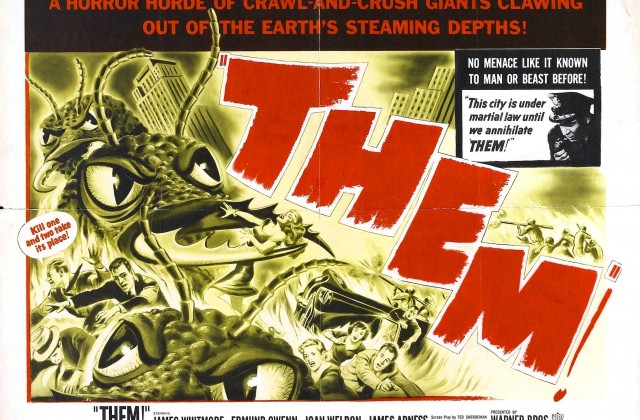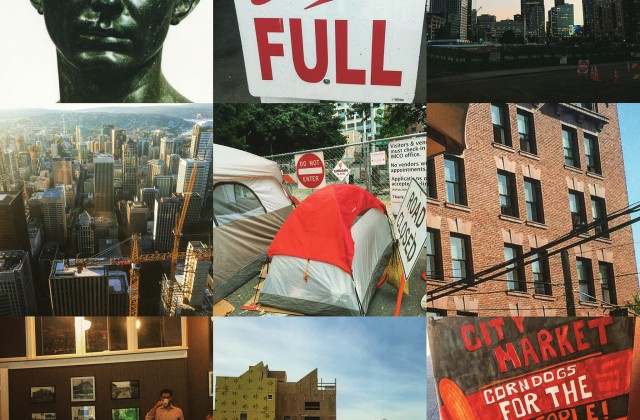Foreign Investor Menace? No, Just Build More Housing!
There is a scary story being told around campfires and coffee shops about shadowy foreign investors, mainly from China, who are buying up all the housing in Seattle and Vancouver, B.C. and then leaving the housing vacant. This, the story goes, is why rents have been going up. As the problem spreads local media and even elected officials are mulling over what we should do. How do we stop this growing menace to our community? The money these investors want to “park” here in Seattle by emptying out our housing might be endless. Well, this scary story is just that, a scary story with no data to back it up. Let’s take a quick look at what’s behind this and how big of a problem it would have to be if it was a real thing.
Human beings have a powerful cultural response to threats to their well being. During the Cold War, Americans expressed and dealt with their fear in many ways, but horror films often, in retrospect, display the angst of the time. One film called Them! is a classic example. Something strange starts happening in New Mexico as locals are killed mysteriously. Then the menace is revealed: giant ants from underground. One of the characters, Dr. Harold Medford, figures it out:
Medford finally reveals his theory: a colony of giant ants, mutated by radiation from the first atomic bomb test near Alamogordo, is responsible for the killings.
You can see how the film, probably unintentionally, has engaged in a profound political and social critique of the Cold War. How did we get into this awful situation of two sides poised on annihilating each other? We did it by irresponsibly splitting the atom and using it as a weapon. Now the menace and fears of extermination from forces outside our control is spreading.
Today in Seattle, Drs Harold and Pat Medford are being played by Charles Mudede and Cary Moon who wrote an extended series of posts in The Stranger about Them!
This flow of Chinese money is looking for the next housing market, and it appears that Seattle and California cities are emerging targets. According to The Guardian, it is underway now. “Geographically, Chinese buyers are concentrated in the most expensive markets: New York, Los Angeles, San Francisco and Seattle.”
Run for the hills! Or better, pass a foreign investors tax on all real estate transactions. Any foreign buyer should have to pay some kind of penalty and be required to rent out their purchases affordably. That will send this menace to its destruction! Load up the Socialist Policy Cannon. Fire! Ready! Aim!
All this would be risible if it weren’t for the fact that it’s catching on. There was a story in the Seattle Times about the Chinese buying up single-family homes. And last week I heard from another reporter asking me if I’d have an issue with a foreign investor tax.
My response, issued with audible eye-rolls, was first, it isn’t happening. There is simply no evidence that there are billions of dollars in cash being dumped into our housing economy from abroad. Even Mudede and Moon don’t give any solid evidence. We can’t even define and measure what “displacement” or “gentrification” are, and those are things that are in common currency in the housing debate even though their value is set by a kind of intellectual barter economy. People pass those words around not knowing what they mean, but knowing how to use them to reenforce the conclusions they’ve already reach. Now along with those code words for socializing the housing economy we can add “foreign investors.”
Second, I said, even if there were a cabal of foreign billionaires wanting to buy up local housing, why on God’s Green Earth would they leave it vacant. One real estate broker I talked to who does big deals with lots of big buyers told me this whole story is a farcical.
It’s not happening, and to the extent that there is foreign money in town, it’s buying buildings and operating them, not leaving them empty. These people didn’t become rich by being stupid.
Exactly. But let’s say this forming menace is gathering above our city, poised to annihilate us and our way of life. Just how much housing would the billionaires have to buy, empty out, and let sit vacant before it would actually have a impact on the price everyone else pays for housing? I asked an expert, Mike Scott of Dupree + Scott.
Based on the relationship between rent and vacancy over the past 17 years, a 1/2% drop in the vacancy rate appears to push rents up 1.0%. So, with about 280,000 units in 20-unit and larger market rate apartments in the region, you would have to demolish (or vacate) 1,400 apartment units to create that rent increase. However, there are a lot of other factors to consider – primarily that the region added over 10,000 new units last year and again this year with even more to be added in each of the next 4+ years. Then there are issues of income levels, demographics, and more that will impact the result.
So for Them! to be able to push up everyone’s average rents up by 1 percent, the menacing foreign investors would have to acquire, empty out, and let sit about 1,400 rental units. Yes, 1,400! To give you a sense of the scale of this kind of purchase, based on participants in the City’s Multifamily Tax Exemption program, Them! would have to buy and empty out the Lyric and Joule apartment buildings on Capitol Hill, the Stackhouse in South Lake Union and the Thornton Creek building in Northgate just to get to about 1000 units.
Why would anyone in their right mind do that? What could possibly justify the time and energy of “parking” cash in empty real estate on such a scale? Who cares, it’s a great story! And evil knows now bounds.
Humans do very weird things when confronted with dissonance in their economy and culture. During the Cold War we looked at ourselves and realized that we had become, as J. Robert Oppenheimer put it quoting Hindu scripture, “Death, the destroyer of worlds.” The truth of nuclear weapons was scary enough, but if we did what was truly indicated, stop making such horrible weapons, we’d expose ourselves to the threat of them being used on us by our enemies. We coped by telling scary stories about giant mutated ants crawling out of the ground and slowly exterminating us. It’s called catharsis.
Now I’m no Jungian cultural social psychologist. But I’ve looked under the bed, and no, there are no foreign investors buying up all the housing in Seattle and leaving it empty. Yes, I checked the closet too. What is true, and truly horrific, is that we are not building enough housing and we’re spending time on wild stories of foreign investors buying up everything;this is a distraction from the urgency of solving the real problem. While we waste time scaring ourselves, real people are suffering from housing scarcity.
Don’t be surprised to see our own City Council, like the panicked officials in the 1950s horror films, slapping their heads and pointing at maps and charts and graphs and passing a foreign investment tax instead of loosing the pent up productivity that could meet housing demand. So instead of stories of evil foreign investors or radioactive ants, let us consider the bees and the vines instead:
THEN leave Complaints: Fools only strive
To make a Great an honest Hive.
T’enjoy the World’s Conveniencies,
Be famed in War, yet live in Ease
Without great Vices, is a vain
Eutopia seated in the Brain.
Fraud, Luxury, and Pride must live;
Whilst we the Benefits receive.
Hunger’s a dreadful Plague no doubt,
Yet who digests or thrives without?
Do we not owe the Growth of Wine
To the dry, crooked, shabby Vine?
Which, whist its shutes neglected stood,
Choak’d other Plants, and ran to Wood;
But blest us with his Noble Fruit;
As soon as it was tied, and cut:
So Vice is beneficial found,
When it’s by Justice lopt and bound;
Nay, where the People would be great,
As necessary to the State,
At Hunger is to make ’em eat.
Bare Vertue can’t make Nations live
In Splendour; they, that would revive
A Golden Age, must be as free,
For Acorns, as for Honesty.
From The Grumbling Hive, by Bernard Mandeville, 1705
You’ve Come a Long Way on Housing Supply, Seattle; Sort of
I remember it clearly, and to protect the guilty I won’t name names. But the conversation was about — what else? — housing, and I was with a person who worked for the Mayor’s office at the time and some other familiar faces of urbanism.
Why, I asked wasn’t the Mayor’s housing committee (yes there was one then, too) looking at the importance of supply.
“More supply is good, but it won’t lower housing prices.”
Huh?
Then two out of the other three people at the table agreed. They just didn’t believe more supply would have a beneficial impact on housing prices. Rents only go up, they said. And if I wanted to be “effective” I should drop the supply argument. Too divisive.
So in looking over where Smart Growth Seattle has been, and my own trip through housing and growth discussions, I’ve always been amazed at the games people play with themselves in Seattle to be nice. Not divisive. Even when it’s about the facts.
The good news is that today, three years later, just about all Urbanists (whatever that means) are united : we need more housing supply. As the Virginia Slims add used to say, “You’ve come a long way baby.” Everyone at that table today, I think, would have their rap down: more housing is good because it provides more options for people at all levels of income. And the Mayor’s Housing Affordability and Livability Agenda (HALA) Committee, unlike earlier committees, was much more aligned to the idea that the production of more market housing is a solution to price increases.
But that’s where it ends. There isn’t broad agreement on how to create the supply. And there even supply-siders who support inflationary measures like Mandatory Inclusionary Zoning and even rent control. Supporting more supply to solve our housing shortage has become the new “environmentalistism” — even Donald Trump would say he’s an environmentalist.
Still, it’s an important transformation from the arguments I had with really smart people as long as five years ago who said, “Housing is a different kind of product in a different kind of market,” or others who called me, Roger “Housing is bananas” Valdez. Of course bananas are different from housing, but scarcity of either will make them more expensive.
How did the supply-side transformation happen? Two ways. First, being relentless in raising supply as a solution in every forum where housing was being discussed and arguing for it. To some significant degree, the supply deniers were worn down, not convinced. And that isn’t because some detente could have been reached. Denying that more housing would help lower prices is a consequence of economics: if I’m here already and own a home, higher prices benefit me. And for those who want more money from government it’s also more beneficial if subsidies are the answer.
Second, people came around to supply because it was a principled stand. Principled positions are more attractive than wishy washy hedges about density and the housing market. Arguing for supply gave shape to an intellectual point of view; people in Seattle like to think of themselves as super smart, even if they aren’t.
Where do we go from here? What will we be arguing about in three years? Sadly, people in Seattle have shown a need for consensus over consistency. We’ll likely be seeing the full effects of the damage done by MIZ in three years if it moves ahead as promised. The non-profit housing developers still won’t have he capital they need because in spite of more fees collected and some units built, the housing scarcity will continue to mean higher prices for land, labor, and financing. The claim that there isn’t enough money in the world to build all the subsidized housing we need will continue.
We’ll also keep seeing red herrings, like the reason prices for housing are high is that rich Chinese people are buying all the housing and leaving if empty. Not to mentions the tens of thousands of units lost to Airbnb speculators making money from their property from tourists rather than “real people.”
It’s likely that the next leap forward for the principle of making more housing as a solution to many problems including prices, energy efficiency, climate change, and water pollution will come after the next downturn. Perhaps we’ll see some people with real business credentials elected to City Council that will champion simple market solutions (lake incentives and lowering costs) to create more jobs. Maybe those Councilmembers will call us and say, “How can we help you make more housing and the jobs and value it creates?”
I can assure you builders and developers won’t say, “More zoning,” or “Upzones!” What I’ve learned over the last twenty years is that people who make housing happen want more certainty and a shorter time to get their product to market. A guy selling bananas can adjust his price on the spot to respond to the market; imagine if his bushels of bananas were still in design review when demand for bananas fell or went up. We shouldn’t and can’t compromise with people who stand in the way of creating a good for the community.
We’ve come a long way. And we’ve got a long way to go yet. But what would help is kicking the consensus habit. If a proposal doesn’t unwaveringly promote more housing without penalizing it we’re against it, period. We get very few benefits from making the problems worse with half measures. We know what the answer is; let’s act like it.
California Here We Come: Housing Forum to Cover Causes and Solutions to the Housing Shortage
I’ll be attending and speaking at a forum on Thursday in Sacremento hosted by the California Apartment Association. I hope to learn more from them and share where we’re headed on housing in Seattle.
CALIFORNIA HOUSING FORUM
Inadequate housing stock threatens California’s economic future. We will explore not only the causes of California’s housing crisis, but also real solutions to this critical problem.
AGENDA
10:00 a.m. – 10:10 a.m.
Welcome and Introduction – Tom Bannon, Chief Executive Officer, California Apartment Association
10:10 a.m. – 10:40 a.m.
Introduction to California’s Housing Drought – California’s High Housing Costs, Causes and Consequences – Mac Taylor, Legislative Analyst, Legislative Analyst’s Office
10:40 a.m. – 11:40 a.m.
California’s Housing Drought: what is the problem? Perspectives on California’s lack of housing and why it is important.
Moderator: Betsy Stark, Former Business Correspondent for ABC News
Panelists:
• Asm. David Chiu, Chair of the CA Assembly Housing and Community Development Committee
• Liam Dillon, Housing correspondent for the Los Angeles Times
• Ralph McLaughlin, Chief Economist for Trulia
• Sonja Trauss, Principal at the Bay Area Renters’ Federation
11:40 a.m. – 12:00 p.m.
LUNCH
12:00 – 1:00
Barriers to new housing in California. What makes California a unique place to build? What are the challenges to new construction in California cities and how might we learn from other states?
Moderator: Betsy Stark, Former Business Correspondent for ABC News
Panelists:
• Brian Augusta, Legislative Advocate for the Western Center on Law and Poverty
• Doug Shoemaker, President of Mercy Housing Group
• Robert Wassmer, Professor of Urban Planning at Sacramento State University
• Marina Wiant, Policy Director for the California Housing Consortium
1:00 – 2:00
Looking Ahead. Possible solutions to California’s housing crisis. Concrete policy solutions for California’s housing dilemma.
Moderator: Betsy Stark, Former Business Correspondent for ABC News
Panelists:
• Tom Bannon, CEO of the California Apartment Association
• Ben Metcalf, Director of the California Department of Housing and Community Development
• Matt Regan, Senior Vice President for Public Policy at the Bay Area Council
• Mark Stivers, Consultant for California State Senate Committee on Transportation and Housing
• Roger Valdez, Director of Smart Growth Seattle and Forbes contributor
Where We’ve Been, Where We’re Going
Each year, as part of my annual report to our board, funders, and allies, I write a kind of State of Smart Growth introduction. It’s also intended to be encouragement for our sometimes beaten down side of the growth, housing, and density argument — and for me who is the guy that does this all day. My plan is a write a couple more reflective posts as we consider the end of one year and the beginning of the next.
We began Smart Growth Seattle with a sense of optimism. Wewere an extraordinary alliance of small, medium, and large housing producers with commercial developers against a gathering storm of regulatory overreach by the City of Seattle. Today, our community is divided, with larger commercial and residential developers in Downtown and South Lake Union supporting a Grand Bargain that creates certainty for them, but uncertainty for us.
By mandating fees and performance, The Grand Bargain, when fully implemented, will cause some projects to become infeasible,raise housing prices (adding to inflation for consumers), and isillegal, violating State law’s clear limits on fees on new housing development.
In rental housing policy, we’ve seen a steady and slow effort to accomplish rent control piecemeal through passage of more and more limits on how private building owners rent and manager their own properties. A shift in State government could end the preemption on local governments imposing rent control, leadingto a rent control proposal in Seattle.
Where do we go from here? We can’t give up! We’ve been a prescient and principled voice of opposition to efforts that will make producing and operating housing in the city of Seattle more costly and expensive.
We can also become, with more resources, a more positive yetprincipled voice, explaining and showing how important our people are in creating housing that is accessible and affordable to a wide array of people with a diverse set of needs and incomes.
Compromising with bad housing policy isn’t an option; working with the City to find areas of agreement is what we should do. We must point out the deep flaws in the Grand Bargain and Mandatory Inclusionary Zoning, oppose efforts to achieve rent control in Seattle, and push the City to follow other recommendations made by the Housing Affordability and Livability Agenda (HALA) Committee, especially expanding housing supply and reducing the time and cost of producing new housing.
I’ve typically made a reference to a classical figure in these annual summaries. This year, I turn to Cato the Younger who was one of few who stood up to the growing tyranny of Julius Caesar. Seen as morose and obdurate by many, he alone predicted and opposed the inevitable power grab the great general was making even while supported by the majority of Romans. “Now,” shouted Cato, “those things are come to pass which I foretold to you, and the man is at last resorting to open compulsion.”
The year ahead is not going to be an easy one, but it is an important one. We’ve been smarter than most in recognizing our limits but we haven’t given up making our points, even when it makes those in power uncomfortable. If we can maintain our effort through 2017, I believe we’ll have proven our value to our community both in good times and bad.
Homelessness and Encampments: What Can Seattle Learn from Utah?
Seattle’s Mayor Ed Murray took to the pages of the Seattle Times recently to bemoan the criticism he’s been getting for his proposal to sweep away homeless encampments throughout the city. Murray said that activists and supporters of a different approach were playing, “a tired, old ideological game,” starting a “food fight,” and engaging in “demonization of him.” The Mayor, it appears, thinks he’s being treated unfairly, hardly an encouraging attitude coming from the person that should be bringing people together around a solution. If the Mayor was actually being a leader, what might he take from work done in Utah to address homelessness?
As I pointed out in an earlier post, Utah’s efforts have been anchored in setting clear definitions, collecting the best data possible, and looking for successful outcomes not rewarding inputs or following rules. But how did Utah get through what surely had to be a daunting conversation – even argument – over the definition of chronic homelessness or whether it was a good idea to focus on that one segment of the problem. According to Lloyd Pendleton, an executive loaned to the State by the Mormon Church, it was three key things: champions, collaboration, and compassion.
Champions
Pendleton talked about his own experience with the Ford Motor Company and his own proclivity to get things done. He described a champion as a person who could look at the overall good rather than the good accruing to her own organization or interest. Most importantly, a champion looks not so much at process – although process is important – but at accomplishing the overall goal, even if that means some players feel like they lost or that success came at their expense.
Pendleton benefitted from being at the end of his career, and as an executive on loan not having to be worried about getting reelected or what effect his views or direction might have on his future. He was out of the organization chart, and, “above the silos.” Seattle would benefit greatly from someone outside the City structure and not accountable to Murray but to achieving outcomes to move solutions along. Usually, leadership for efforts here comes from within the City organization chart, meaning the solutions are about Murray’s reelection and his ego.
Collaboration
Murray has tried to motivate this in Seattle but has largely failed. While his Housing Affordability and Livability Agenda (HALA) Committee was working the way Pendleton described, he broke a small group of big developers to cut a deal, a Grand Bargain that excluded everyone else. The Bargain, of course, was and has been touted as, “historic,” of course because it fits the narrative of compromise and collaboration, but it’s anything but that.
Pendleton pointed out that the State’s efforts to reign in the pain of homelessness was not about what people didn’t want – homelessness – but about what the everyone engaged in the process wanted:
Everyone has access to safe, decent, affordable housing with the needed resources and supports for self-sufficiency and well being
This brought various groups together around an outcome that was beneficial to each of their constituencies rather than a Quixotic goal of “ending homelessness.” Collaboration wasn’t easy, but having a positive vision helped rally people around a cause. Murray has a tendency to think leadership means putting stakeholders in a room, closing and locking the door, and pressuring them with foot stomping and yelling to agree on a “solution” within a limited timeframe. That’s hardly establishing a vision and building support for it.
Compassion
Everyone in Seattle looks in the mirror in the morning and certainly sees a compassionate person. But are we really? I could write – and maybe will in another venue – about Pendleton’s discussion with me about the, well, for lack of a better word, spiritual level of engagement needed to work on such a difficult problem. But there must be a high degree of connection with the people who are suffering. The toughness of definitions and data must be combined with genuine love and warmth toward people struggling with the many issues that contribute to homelessness.
Sometimes our local politicians confuse maudlin self-exposure of their own history with compassion. The Mayor engaged in this in the Seattle Times story, pointing to his own hardscrabble childhood as proof that he, “gets it.” It’s tempting to substitute genuine compassion with our own stories of how we’ve suffered. But that won’t help rally people around a cause.
Utah’s Lieutenant Governor Spencer Cox, “gets it:”
The message from the pulpit continues to persuade ordinary people to commit to solving homelessness as well, Cox said.
“I had to have my own conversion and the only way to do that is spend time with the homeless people and talk to them,” he said. “It changes everything.”
Cox did not mention that he and a legislator, who is a board member of The Road Home, donned “ranch clothes” and spent a night sleeping in the shelter, Pendleton later said.
And Cox didn’t tell anyone he was going into the shelter and there was no press conference afterward. He did it completely incognito.
What Can Seattle Learn From Utah?
To recap, Seattle has a small, easily identifiable group of people suffering from an array of challenges: they are living in the so-called encampments. We know where these people are. It’s probably pretty easy to come up with a definition of the problem that is leading to encampments and really easy to talk with the people, ask questions, then set about to bring resources to bear on the variety of issues that have lead them to solve them with a tent encampment.
This would require work. It would mean the Mayor would have to give away power to drive and control the work to a group with leadership not on anyone’s organization chart. And it would take time and collaboration and process to get to a common vision.
Pendleton said, “When someone really disagreed with me, I’d put them on the committee.” Pendleton was adamant, “You’ve got a point of view and we need to hear from you and get your ideas.” Mayor Murray has done exactly the opposite, banishing some key leaders like Real Change’s Tim Harris to a virtual Siberia.
Sweeping away the encampments would remove and eyesore from some areas in the city. It might even score the Mayor some political points for, “doing something.” Passing legislation might score the Council points too among other groups. But if we really listened to what Utah is telling us, we’d start by listening to the people in the encampments. They’ll tell us what the solution is. Then we need some leadership that is less interested in scoring points than defining and solving real problems.







